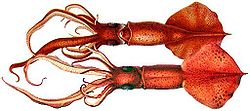| Mastigoteuthis flammea | |
|---|---|
 | |
| Type of Mastigoteuthis flammea (35 mm ML) | |
| Scientific classification | |
| Kingdom: | Animalia |
| Phylum: | Mollusca |
| Class: | Cephalopoda |
| Order: | Oegopsida |
| Family: | Mastigoteuthidae |
| Genus: | Mastigoteuthis |
| Species: | M. flammea |
| Binomial name | |
| Mastigoteuthis flammea | |
Mastigoteuthis flammea (Flaming whiplash squid [2] ) is a species of whip-lash squid.
- Dorsal view of nuchal cartilage

